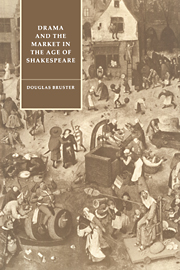Book contents
- Frontmatter
- Contents
- Preface
- Acknowledgments
- A note on texts
- 1 Toward a material theater
- 2 Drama and the age
- 3 “City comedy” and the materialist vision
- 4 Horns of plenty: cuckoldry and capital
- 5 The objects of farce: identity and commodity, Elizabethan to Jacobean
- 6 The farce of objects: Othello to Bartholomew Fair
- 7 “The alteration of men”: Troilus and Cressida, Troynovant, and trade
- Notes
- References
- Index
6 - The farce of objects: Othello to Bartholomew Fair
Published online by Cambridge University Press: 11 September 2009
- Frontmatter
- Contents
- Preface
- Acknowledgments
- A note on texts
- 1 Toward a material theater
- 2 Drama and the age
- 3 “City comedy” and the materialist vision
- 4 Horns of plenty: cuckoldry and capital
- 5 The objects of farce: identity and commodity, Elizabethan to Jacobean
- 6 The farce of objects: Othello to Bartholomew Fair
- 7 “The alteration of men”: Troilus and Cressida, Troynovant, and trade
- Notes
- References
- Index
Summary
The handkerchief which Othello gives Desdemona as a “token” of their love forges a fort-da link between the two in much the same way as Antipholus' chain eventually bound him to Adriana, and in the way Jane was connected to Ralph through her shoes. As I will argue, the handkerchief retains a social significance that depends on English society's growing commercialism. Yet in communicating the sense and signs of identity, the handkerchief also possesses a kind of internal significance characteristic of the Jacobean drama and its tendency toward the commercial inscription of identity. In this way it remains both part of a historical narrative driven by a developing market, and part of a literary narrative itself drawing power from and responding to this market-centered energy.
The strange importance of the handkerchief to the drama's action has long been noted. Thomas Rymer's well-known characterization of Othello (1604) as a “Bloody Farce” in his “Short View of Tragedy,” for instance, springs from the neoclassical view that Shakespeare violated the rules of decorum by making, in Rymer's words, “a Tragedy of this Trifle.” Rymer regretted the disparity between cause and effect in Othello, thinking the handkerchief too trivial an object to excite such passion in the Moor:
Had it been Desdemona's Garter, the Sagacious Moor might have smelt a Rat: but the Handkerchief is so remote a trifle, no Booby, on this side Mauritania, cou'd make any consequence from it.
- Type
- Chapter
- Information
- Drama and the Market in the Age of Shakespeare , pp. 81 - 96Publisher: Cambridge University PressPrint publication year: 1992



